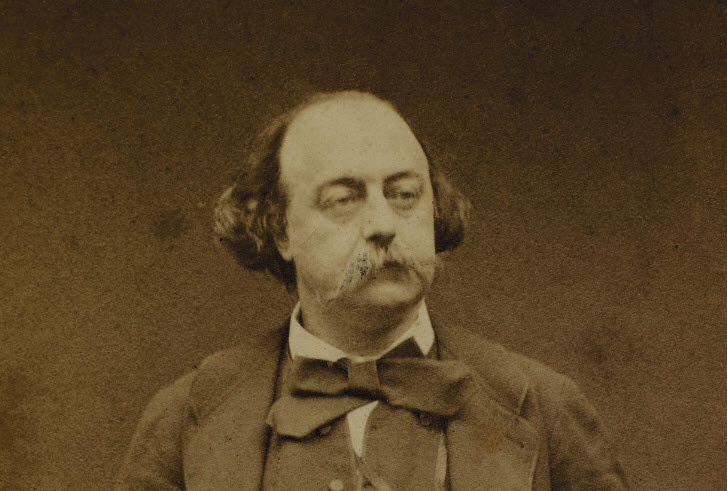Information on French writer Gustave Flaubert works, writings, novels, books. Gustave Flaubert works history and features.

Flaubert wrote much but published nothing until he was 36 years of age. The product of five years of “agony,” Madame Bovary (originally published serially in the Revue de Paris, 1856-1857), tells the story of a provincial wife who seeks release from the boredom of her marriage in adultery and romantic dreams. Her illusions and her debts finally drive her to suicide. Flaubert’s detached style leaves the banality of the story undisturbed and surrounds it with an intensity of detail and awareness that the French “antinovelist” Nathalie Sarraute has termed “a new psychological substance.” Boredom and the commonplace are given their full due.
Flaubert’s youthful narratives, which are largely autobiographical, reveal his struggles to escape the restraints of his bourgeois upbringing and control his somewhat unbalanced temperament. Two works produced before Madame Bovary were to be entirely rewritten and published 20 years later. The first was L’éducation sentimentale, an account of a young man’s falling in love with an older married woman (the Marie Arnoux in that work being the counterpart of Elisa Schlésinger ). The second, both more ambitious and more pompous, was a semidramatic fantasy called La tentation de Saint Antoine, inspired in part by Pieter Bruegel the Elder’s engraving the Temptation of Saint Anthony and by Goethe’s Faust. His friends convinced him of its weakness and urged him to explore the contemporary theme of Madame Bovary.
After the notoriety produced by Madame Bovary, Flaubert returned to an exotic and historical setting in Salammbô. He did extensive reading and visited Tunisia in 1857 to document this opulent story of love and cruelty in ancient Carthage. It was poorly received, although it established his reputation for realism based on painstaking research and documentation.
The final versions of L’éducation sentimentale (1869) and La tentation de Saint Antoine ( 1874 ) were followed by publication of Trois contes (1877), a collection of three stories entitled Un coeur simple, La légende de Saint Julien l’Hospitalier, and Hérodias. In these stories, set, respectively, in modern times, the Middle Ages, and antiquity, Flaubert’s artistry approached perfection. When he died, he was working on the last chapter of an episodic and encyclopedic novel, Bouvard et Pécuchet ( published posthumously, 1881). This work concerns two Paris clerks who retire to the country and try, with grotesque yet very human results, to educate themselves. It was Flaubert’s counterpart of Cervantes’ Don Quixote.
In all his work Flaubert directed his attention to three interpenetrating themes—boredom and escapes from boredom, the nature and temptation of evil, and the persuasive products of a hallucinated imagination in its efforts to transform reality. He scrupulously portrayed moeurs (social customs), whether ancient or contemporary. He sought with an obsession that has become legendary the exact word to express his thought—le mot juste.
The work of this supreme stylist was really written in several distinguishable modes. In Madame Bovary, in the story Un coeur simple, and in the second version of L’éducation sentimentale, Flaubert chastened his prose and produced a spare and flexible form of expression for psychological states. Point of view became a conscious element in his narrative, creating an effect of impersonality and irony. In the works treating exotic subjects, particularly Salammbô, he developed a sensuous descriptive style that some modern critics read as an anticipation of the French nouveau roman of the mid-20th century, an abstract prose that almost divests itself of narrative impulse. (Flaubert in a letter spoke of composing “a novel about nothing.”) The spontaneous, lively style of Flaubert’s correspondence contrasts markedly with that of his formal writings and demonstrates the degree to which he labored to achieve perfection in his novels. Proust refers to their “grammatical beauty.”
Flaubert’s works have been printed in numerous editions in France and translated into most languages. Interest in his artistry also has led to publication of the early drafts of some of his novels. The one truly complete edition of his works is that of the Librairie Conard in 28 volumes, begun in 1910 and not completed until 1954. It includes the early writings, drafts, and revisions of his major works, 9 volumes of correspondence, and a 4-volume supplement to the correspondence. Several other critical and annotated editions are available. The most compact of these is edited in two volumes by Albert Thibaudet and René Dumesnil in the Bibliothèque de la Pléiade (Paris 1936).